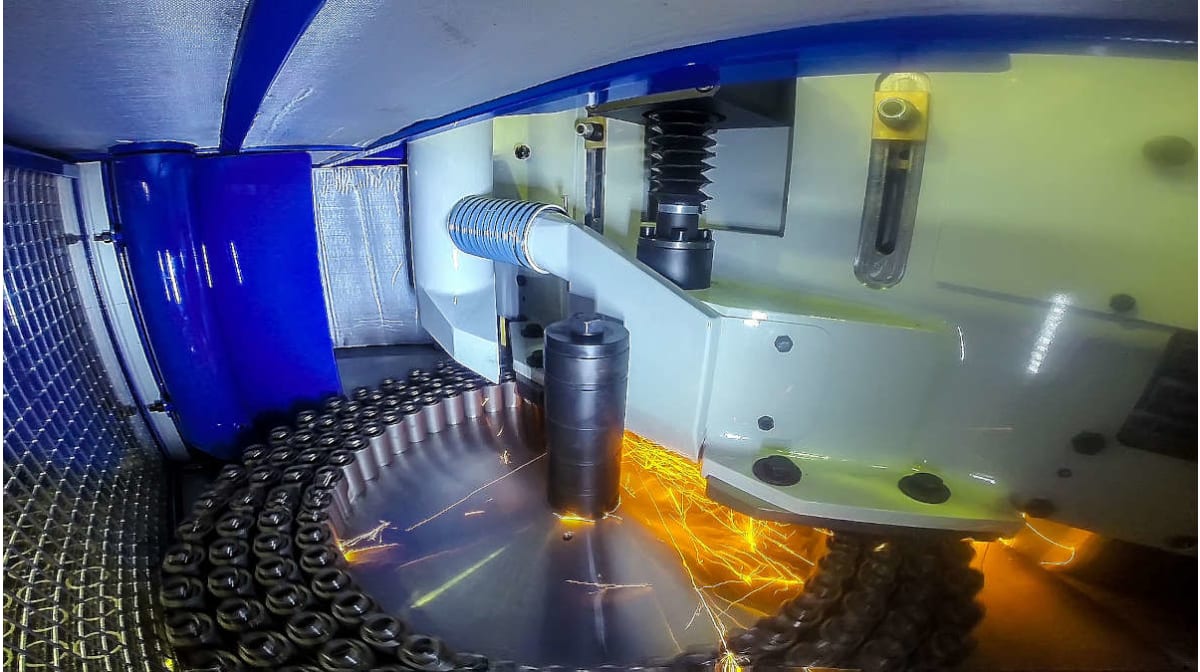Compression spring grinding machines by OMD

OMD, a leading Italian company in the spring machinery sector, offers a complete range of automatic grinding machines, designed to meet the needs of modern production lines. In this article, we go over some of the key design aspects.
What is spring grinding and why is it essential?
In spring manufacturing, grinding is an essential process used to shape the ends of compression springs, ensuring stability, flatness, and dimensional accuracy. Depending on application requirements, one or both ends can be ground. Double-end grinding — known as parallel-end grinding — is the most common solution when symmetrical support and consistent precision are required during the spring's operation.
Loading plates: one or two?
OMD grinders can be configured with one or two loading plates for transporting the springs into the grinding cubicle.
• Single loading plate: all stages (loading, grinding, unloading) occur sequentially. This configuration is compact, efficient, flexible, and allows for continuous grinding and/or automatic cycle operation.
• Two loading plates on a rotating table: while one plate is in the grinding position, the other is in the loading/unloading position; cycle time is reduced and productivity increased. Grinding is performed automatically in a continuous cycle.
Grinding wheels: one or more pairs?
OMD spring grinding machines can be configured with one or more pairs of opposed vertical-axis spindles. In machines with two or more pairs of grinding wheels, the loading plate moves the springs through different grinding cubicles. Each cubicle performs a separate operation; roughing and finishing. At the end of the process, the springs are discharged by gravity.
Multi-head grinding machines are suitable for high-volume production and allow for the intermediate operation of spring settling.
Grinding wheels: conventional or CBN?
Depending on spring geometry and material type, either conventional or CBN (Cubic Boron Nitride) wheels can be used. OMD machines can be configured to work with both types of abrasives.
Air cooling vs water cooling
The cooling system controls the process temperature and directly impacts quality and productivity. The choice of cooling system in OMD grinding machines depends on specific production needs and on the characteristics of the springs to be processed.
• Air cooling: the M and MA series are equipped with an air cooling system for the loading plate and grinding cubicle. This configuration is ideal for springs with wire diameter up to 25 mm. Additionally, extra cooling between the grinding wheels can be integrated to further improve thermal management.
• Water cooling: the H and HA series are specifically designed for water cooling, offering superior thermal control during grinding. These machines are recommended for medium and large springs, with a maximum wire diameter of 95 mm. They are equipped with a coolant recirculation system to maintain a stable operating temperature. They also feature automatic spindle feed for consistent and uniform grinding. Available options include a coolant filtration system for removing metal residues.
OMD’s offering
These are just a few of the design choices to consider when selecting the most suitable grinding machine. Every OMD machine includes electronic process control systems, automatic spring length measurement, abrasive wheel wear compensation, automatic wheel dressing, graphic programming interface, integrated diagnostics, and connectivity for remote assistance. Additionally, the grinding machine can be equipped with an automatic loading system, either traditional (ALM) or robotic (RLM), and/or a spring settling system.
OMD’s team is available to help you evaluate your production needs and recommend the most suitable grinding solution.

- Used machinery and equipment •
- Spring machines •
- Various spring machines •
- Multi-former for springs •
- Spring coilers •
- Spring end grinding machine •
- Lathe coilers



